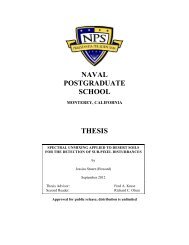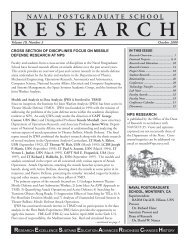High Energy Laser Testbed for Accurate Beam Pointing Control
High Energy Laser Testbed for Accurate Beam Pointing Control
High Energy Laser Testbed for Accurate Beam Pointing Control
Create successful ePaper yourself
Turn your PDF publications into a flip-book with our unique Google optimized e-Paper software.
2.2.2 Narrow Field-of-View (NFOV) Video Tracker <strong>Control</strong> Loop<br />
The NFOV control loop shown in Figure 6 includes an integrator type compensator (on each axis).<br />
Figure 6. NFOV <strong>Control</strong> Loop<br />
2.2.3 Alignment and <strong>Beam</strong> Jitter <strong>Control</strong><br />
The auto-alignment/jitter control FSM is controlled using an analog controller with an adjustable gain. The PSD signal is<br />
used as a feedback signal to the analog controller.<br />
2.3 System Identification<br />
Several types of experiments were per<strong>for</strong>med to determine characteristics of the HEL testbed. The results of the tests<br />
were utilized <strong>for</strong> system modeling. The experiments include resonant frequency test, rate loop servo bandwidth and<br />
stabilization test, FSM test, and NFOV bandwidth test. The target computer has an external terminal board which<br />
interfaces all the signals between the beam control system and target computer. It also provides input/output test points.<br />
Test equipment such as a dynamic signal analyzer, data acquisition system, and oscilloscope are used <strong>for</strong> signal<br />
generation, data storage, and observation of test signals.<br />
2.3.1 WFOV Resonance Frequency<br />
Random signals were applied to the power amplifier of the azimuth and elevation gimbal stages and output signals were<br />
received at the gyro and encoder respectively. With this open loop tests, resonance frequencies were calculated using<br />
power spectral density analysis. Prior to per<strong>for</strong>ming the analysis, preprocessing was required to remove constant drift in<br />
addition to outliers. The resonance frequencies are determined over a frequency range of 0-200Hz.<br />
Table 1 – Summary of Resonance Frequency Test<br />
Direction Output signal Resonance frequencies (Hz)<br />
AZ<br />
EL<br />
Gyro 2.6, 8.3, 11.4, 15.9, 36.6, 69.5, 101, 134, 147.7<br />
Encoder 2.6, 8.2, 11.4, 101<br />
Gyro 3.8, 10, 14.9, 43.3, 61.4, 74.5, 101, 145, 195<br />
Encoder 3.8, 11.6, 61.4, 101<br />
2.3.2 WFOV Rate Loop Serve Bandwidth<br />
Rate loop bandwidth was measured by applying a sweep sine signal to rate command and observing output at the gimbal<br />
gyro. As with resonance testing, preprocessing was conducted <strong>for</strong> trend removal and outlier rejection. Data was<br />
measured from 1-50Hz <strong>for</strong> both axis. The ultimate goal of this testing is to determine the transfer function of the rate<br />
loop servos. Several intermediate calculations were required to make this determination, the first of which is the crosscorrelation<br />
sequence as given by<br />
R m = E x ⋅ y = E x ⋅ y<br />
(1)<br />
* *<br />
xy ( ) { n+ m n } { n n−m} Proc. of SPIE Vol. 7587 75870G-5<br />
Downloaded from SPIE Digital Library on 31 Jul 2012 to 205.155.65.56. Terms of Use: http://spiedl.org/terms
















